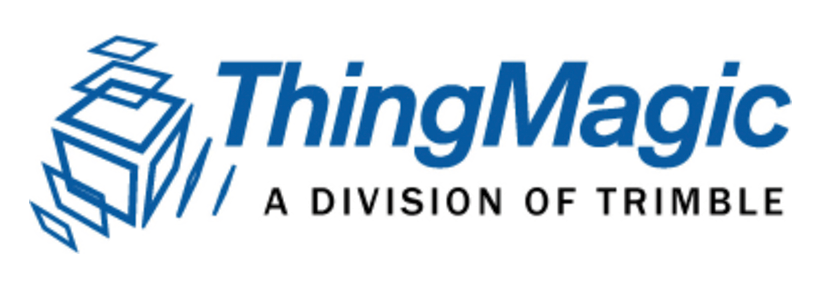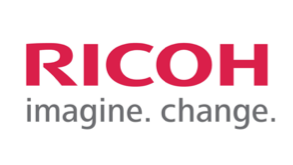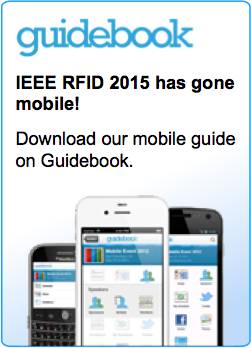 The Best Paper Award is sponsored by ThingMagic!
The Best Paper Award is sponsored by ThingMagic!
(listed in no particular order)
Coding for Tag Collision Recovery
Hessam Mahdavifar and Alexander Vardy
University of California San Diego, CA
Abstract
 It
has been recently observed that some information can be extracted from
the received signal by the reader when the tag collision happens. Using
the radio cross section (RCS) technique one can determine how many tags
are backscattering simultaneously. Motivated by this technique we
introduce the new notion of singulation code. In a singulation code, any
two collection of codewords, of size up to some number $s$, have
distinct vector-sums. We propose a new protocol for tag singulation
problem using the singulation codes. Upper and lower bounds on the size
of singulation codes are provided. It is shown that there exists
families of singulation codes that guarantee any positive throughput,
asymptotically, using the singulation coding protocol. Two explicit
constructions of singulation codes, with low complexity encoding and
decoding algorithms, are proposed. It is shown that these constructions
are feasible to be implemented in RFID tags. The singulation protocol
with these explicit constructions is compared with the randomized ALOHA
based algorithm. It is shown that the time required for the tag
identification with the proposed protocol is reduced by a factor of log
“s” comparing to the randomized ALOHA based algorithm, where “s” is the
number of tags to be identified. Other advantages of the proposed
protocol are also discussed.
It
has been recently observed that some information can be extracted from
the received signal by the reader when the tag collision happens. Using
the radio cross section (RCS) technique one can determine how many tags
are backscattering simultaneously. Motivated by this technique we
introduce the new notion of singulation code. In a singulation code, any
two collection of codewords, of size up to some number $s$, have
distinct vector-sums. We propose a new protocol for tag singulation
problem using the singulation codes. Upper and lower bounds on the size
of singulation codes are provided. It is shown that there exists
families of singulation codes that guarantee any positive throughput,
asymptotically, using the singulation coding protocol. Two explicit
constructions of singulation codes, with low complexity encoding and
decoding algorithms, are proposed. It is shown that these constructions
are feasible to be implemented in RFID tags. The singulation protocol
with these explicit constructions is compared with the randomized ALOHA
based algorithm. It is shown that the time required for the tag
identification with the proposed protocol is reduced by a factor of log
“s” comparing to the randomized ALOHA based algorithm, where “s” is the
number of tags to be identified. Other advantages of the proposed
protocol are also discussed.
NFC-WISP: A Sensing and Computationally Enhanced Near-Field RFID Platform
Yi Zhao, Joshua R. Smith and Alanson P. Sample
Disney Research Pittsburgh, PA
Abstract
 Near-field
radio frequency identification (RFID) tags have a number of unique
features such as being wirelessly powered, having ultra low power
communication capabilities, small size, and low cost. These qualities
paired with the increasing availability of commodity near field
communication (NFC) enabled smart phones presents a significant
opportunity to enable a wide range of new applications and usage
scenarios. However, existing tags are fixed function devices that are
only capable of reporting an ID when queried and thus most applications
are limited to inventory management or access control.
Near-field
radio frequency identification (RFID) tags have a number of unique
features such as being wirelessly powered, having ultra low power
communication capabilities, small size, and low cost. These qualities
paired with the increasing availability of commodity near field
communication (NFC) enabled smart phones presents a significant
opportunity to enable a wide range of new applications and usage
scenarios. However, existing tags are fixed function devices that are
only capable of reporting an ID when queried and thus most applications
are limited to inventory management or access control.
This paper presents the NFC-WISP, which is a programmable, sensing and computationally enhanced platform designed to explore new RFID enabled sensing and user interface applications. The NFC-WISP is fully powered and read by commercially available RFID readers (including NFC enabled smart phones) using the ISO-14443 protocol. Excess harvested power can be stored in an optional super-capacitor or thin-film battery enabling operation away from the reader. This open-source platform includes temperature and acceleration sensors, 2MB of FRAM, LEDs and an optional 2.7” active bistable matrix E-ink display. Expansion headers allow access to the microcontroller allowing for rapid prototyping of new applications. The use of the NFC-WISP for a perishable goods temperature and motion monitoring application is demonstrated as well as the use of wireless power transfer based on magnetic coupled resonance for high power recharging of multiple NFC devices.
Every Smart Phone is a Backscatter Reader: Modulated Backscatter Compatibility with Bluetooth 4.0 Low Energy (BLE) Devices
Joshua F. Ensworth, and Matthew S. Reynolds
University of Washington, Seattle, WA
Abstract
 In
this work, we show how modulated backscatter signals can be crafted to
yield channelized band-pass signals akin to those transmitted by many
conventional wireless devices. As a result, conventional wireless
devices can receive these backscattered signals without any modification
(neither hardware nor software) to the conventional wireless device. We
present a proof of concept using the Bluetooth 4.0 Low Energy, or BLE,
standard widely available on smart phones and mobile devices. Our
prototype backscatter tag produces three-channel band- pass frequency
shift keying (FSK) packets at 1 Mbps that are indistinguishable from
conventional BLE advertising packets. An unmodified Apple iPad is shown
to correctly receive and display these packets at a range of over 9.4 m
using its existing iOS Bluetooth stack with no changes whatsoever. We
create all three BLE channels by backscattering a single incident CW
carrier using a novel combination of fundamental-mode and harmonic-mode
backscatter subcarrier modulation, with two of the band-pass channels
generated by the fundamental mode and one of the band-pass channels
generated by the second harmonic mode. The backscatter modulator
consumes only 28.4 pJ/bit, compared with over 10 nJ/bit for conventional
BLE transmitters. The backscatter approach yields over 100X lower
energy per bit than a conventional BLE transmitter, while retaining
compatibility with billions of existing Bluetooth enabled smartphones
and mobile devices.
In
this work, we show how modulated backscatter signals can be crafted to
yield channelized band-pass signals akin to those transmitted by many
conventional wireless devices. As a result, conventional wireless
devices can receive these backscattered signals without any modification
(neither hardware nor software) to the conventional wireless device. We
present a proof of concept using the Bluetooth 4.0 Low Energy, or BLE,
standard widely available on smart phones and mobile devices. Our
prototype backscatter tag produces three-channel band- pass frequency
shift keying (FSK) packets at 1 Mbps that are indistinguishable from
conventional BLE advertising packets. An unmodified Apple iPad is shown
to correctly receive and display these packets at a range of over 9.4 m
using its existing iOS Bluetooth stack with no changes whatsoever. We
create all three BLE channels by backscattering a single incident CW
carrier using a novel combination of fundamental-mode and harmonic-mode
backscatter subcarrier modulation, with two of the band-pass channels
generated by the fundamental mode and one of the band-pass channels
generated by the second harmonic mode. The backscatter modulator
consumes only 28.4 pJ/bit, compared with over 10 nJ/bit for conventional
BLE transmitters. The backscatter approach yields over 100X lower
energy per bit than a conventional BLE transmitter, while retaining
compatibility with billions of existing Bluetooth enabled smartphones
and mobile devices.
WISPCam: A Battery-Free RFID Camera
Saman Naderiparizi, Aaron N. Parks, Zerina Kapetanovic, Benjamin Ransford, Joshua R. Smith
University of Washington, WA
Abstract
 Energy-scavenging
devices with general-purpose microcontrollers can support arbitrarily
complex sensing tasks in theory, but in practice, energy limitations
impose severe constraints on the application space. Richer sensing such
as image capture would enable many new applications to take advantage of
energy scavenging. Richer sensing faces two key challenges: efficiently
retaining the necessary amount of harvested energy, and storing and
communicating large units of sensor data. This paper presents the
WISPCam, a passive UHF RFID camera tag based on the Wireless
Identification and Sensing Platform that overcomes these two challenges
to support reliable image capture and transmission while powered by an
RFID reader. The WISPCam uses a novel charge-storage scheme designed
specifically to match the image sensor’s needs. This scheme optimally
balances capacitance and leakage to improve the sensitivity and
efficiency of the power harvester. The WISPCam also uses a novel data
storage and communication scheme to reliably support the transfer of
complete images to an RFID reader application. The WISPCam makes
battery-free image capture practical for applications such as mechanical
gauge reading and surveillance, both demonstrated in this paper, and
opens the door to richer sensing applications on battery-free devices.
Energy-scavenging
devices with general-purpose microcontrollers can support arbitrarily
complex sensing tasks in theory, but in practice, energy limitations
impose severe constraints on the application space. Richer sensing such
as image capture would enable many new applications to take advantage of
energy scavenging. Richer sensing faces two key challenges: efficiently
retaining the necessary amount of harvested energy, and storing and
communicating large units of sensor data. This paper presents the
WISPCam, a passive UHF RFID camera tag based on the Wireless
Identification and Sensing Platform that overcomes these two challenges
to support reliable image capture and transmission while powered by an
RFID reader. The WISPCam uses a novel charge-storage scheme designed
specifically to match the image sensor’s needs. This scheme optimally
balances capacitance and leakage to improve the sensitivity and
efficiency of the power harvester. The WISPCam also uses a novel data
storage and communication scheme to reliably support the transfer of
complete images to an RFID reader application. The WISPCam makes
battery-free image capture practical for applications such as mechanical
gauge reading and surveillance, both demonstrated in this paper, and
opens the door to richer sensing applications on battery-free devices.




